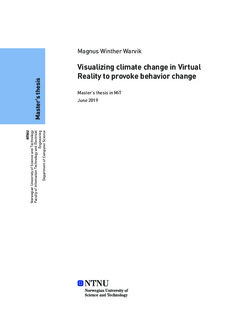| dc.contributor.advisor | McCallum, Simon | |
| dc.contributor.advisor | Prasolova-Førland, Ekaterina | |
| dc.contributor.advisor | Rød, Jan Ketil | |
| dc.contributor.author | Warvik, Magnus Winther | |
| dc.date.accessioned | 2019-11-16T15:00:28Z | |
| dc.date.available | 2019-11-16T15:00:28Z | |
| dc.date.issued | 2019 | |
| dc.identifier.uri | http://hdl.handle.net/11250/2628787 | |
| dc.description.abstract | Klimaendringer er et viktig samfunnsproblem, både globalt og lokalt. Målet med denne undersøkelsen er å diskutere bruk av en Virtual Reality-applikasjon (VR) som et verktøy for å lage empati og endre miljøadferd blant brukerne. Den prøver også å svare på spørsmål om bruk av VR for å visualisere klimadata, og hvordan best vise menygrensesnittene i samme kontekst. Forskningen har vært basert på "design science", med den endelige applikasjonen utviklet gjennom flere implementasjons- og evalueringssykler. Resultatet er en applikasjon som viser klimaendring i byen Trondheim. Brukeren kan se på hvordan et økt havnivå påvirker byen, og visualiseringer av klimadata kan vises på toppen av bakken. Til slutt er det vanskelig å trekke konkrete konklusjoner angående den spesifikke applikasjonen, der mer forskning trenges. Resultatene er positive mot VR for generelt å visualisere og få brukere til å føle med klimaendring. | |
| dc.description.abstract | Climate change is an important societal problem, both globally, and on a local scale. The objective of this research is to discuss the use of a Virtual Reality (VR) application as a tool to provoke empathy and modify environmental behavior among users. It also tries to answer questions regarding using VR to visualize climate data, and how best display menu interfaces in the same context. The research have been grounded in design science, with the final application developed through several implementation and evaluation cycles. The result is an application displaying climate change in the city of Trondheim. The user can look at how an increased sea level affects different parts of the city, and visualizations of climate data can be augmented on top of the ground. In the end, any definite conclusions regarding the specific application are hard to draw, with more research needed. The results are positive towards VR in general to visualize and make users empathize with climate change. | |
| dc.language | eng | |
| dc.publisher | NTNU | |
| dc.title | Visualizing climate change in Virtual Reality to provoke behavior change | |
| dc.type | Master thesis | |
